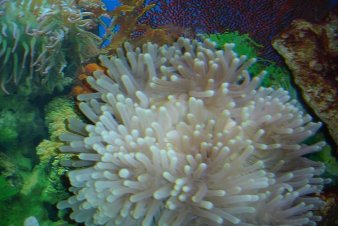Reproduction and Life History
Heteractis
magnifica have an interesting life cycle. Sexes in anemones are
separate, although both sexual and asexual reproduction takes place.
Picture by Elizabeth Guck
In sexual reproduction, unlike most cnidarians, anemones lack the free-swimming medusa stage. The polyp produces the eggs or the sperm, depending on which sex it is, which both are ejected through the mouth. The male usually releases the sperm first, which stimulates the female to release its eggs. After fertilization, the egg will develop into a planula which will find a place to settle. When it is settled, the planula will grow directly into a new polyp, meaning a new anemone.
Heteractis magnifica can also reproduce asexually. They can use budding, binary fission, and pedal laceration. When budding occurs, a new organism will be produced directly from the original organism. This will produce an exact replica of the original anemone. During binary fission, cells will divide into two cells of the exact same size, which is also called mitosis. The final process, pedal laceration, is when a small portion of the pedal disc will break off and will grow into a new anemone.
|
It is very hard to determine a growth rate for Heteractis magnifica, partially because the lack of skeleton. In fact, it is almost impossible to tell the age of an anemone. This is because anemones will grow when food and nutrients are plentiful, but shrink in size if they are deprived of these aspects.
|
||
